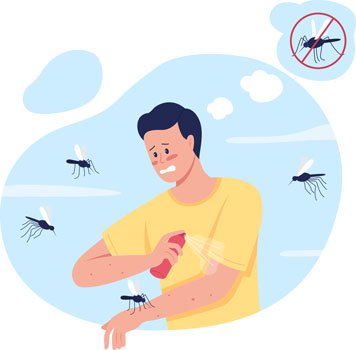Mosquito Species in South Carolina: What You Need to Know
While the mosquito is not, in fact, the South Carolina state bird (that honor goes to great Carolina Wren), these flying bloodsuckers are certainly everywhere! Today we’ll look at five different species of mosquitoes commonly found in South Carolina, and give some practical tips for how to reduce mosquito populations around your home and stay safe from bites.
When is mosquito season in South Carolina?
The unfortunate reality is that South Carolina experiences mosquitoes nearly all year long. The official definition of mosquito season is any day with an average temperature between 50 and 95 degrees and a relative humidity greater than 42%. This means that from March until November you can expect to encounter mosquitoes!
As the climate warms, South Carolina is experiencing a mosquito season that is 11 days longer on average than it was 43 years ago and warmer winters make for a faster return to peak mosquito populations each spring.
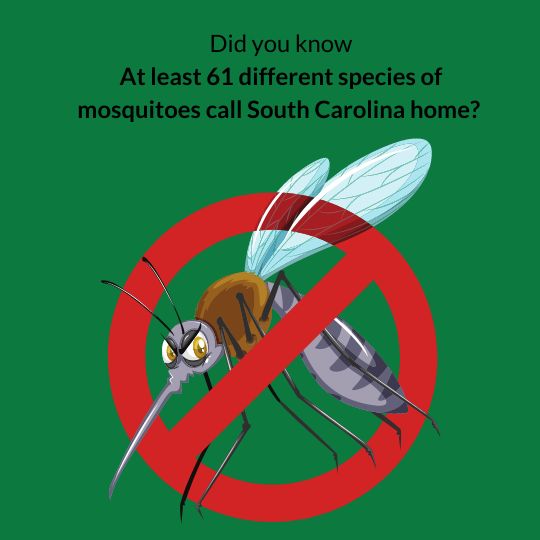
5 Common Types of Mosquitoes in South Carolina
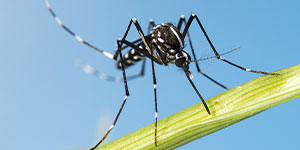
Aedes albopictus, Asian Tiger Mosquito
- Appearance: This species from Asia is small, about 1/4 inch long, with distinctive black and white stripes on its legs and body and a single stripe running down the back of its thorax.
- Active during: Mostly during the daytime. Unlike most mosquitoes, A. albopictus will bite in full sun.
- Lays eggs in: Small containers of standing water like buckets, bowls, bird baths, discarded tires, potted plants, vases, and plants that hold water such as bromeliads.
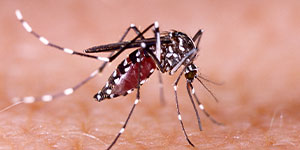
Aedes aegypti, Yellow Fever Mosquito
- Appearance: These mosquitoes are about 1/8 to 1/4 inch long. They have white bands on their legs and a marking in the form of a violin or lyre on the upper surface of its thorax.
- Active during: Primarily during the daytime, with peak activity during early morning and late afternoon. They primarily bite low on the body – generally below the knee.
- Lays eggs in: Clean, stagnant water often found in artificial containers and vessels, including bird baths, barrels, and discarded tires and containers.
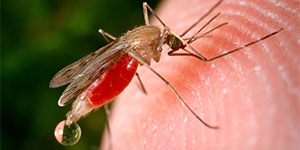
Anopheles quadrimaculatus group, Quads Mosquito or Malaria Mosquito
- Appearance: This group of mosquitoes includes 5 species that look incredibly similar. They are brown and have four dark spots on their wing veins.
- Active during: Mostly during the night, from dusk until dawn. These mosquitoes overwinter in our homes and they can be found flying around on warm winter days.
- Lays eggs in: Freshwater habitats like marshes, swamps, and ponds. They particularly prefer areas with vegetation.
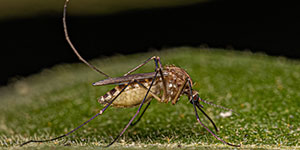
Culex quinquefasciatus, Southern House Mosquito
- Appearance: This light brown mosquito is small to medium-sized, rarely exceeding 1/5th of an inch in length.
- Active during: Nighttime, they are most active from dusk to dawn. As their name implies, these mosquitoes often enter homes in search of a blood meal.
- Lays eggs in: They lay their eggs in rafts on the surface of stagnant water, often in polluted water bodies such as ditches, open septic tanks, and standing collections of rain or tap water.
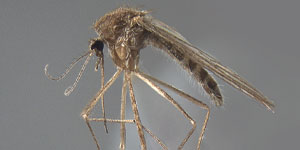
Culiseta inornata, Winter Mosquito
Image sourced from Walter Reed Biosystematics Unit (WRBU)
- Appearance: These large mosquitoes are up to 3/8 inch long, and have a drab, salt and pepper appearance.
- Active during: Evenings and warmer periods during the day in the cooler months. They are known for being active during winter, hence their common name.
- Lays eggs in: Freshwater habitats such as marshes, ponds, and water-filled containers. The larvae can tolerate cold temperatures and overwinter in water.
Do mosquitoes carry disease?
Yes. Mosquitoes are one of the most dangerous animals on earth due to their ability to spread deadly diseases.
Some mosquito-borne diseases, like malaria, were once eradicated in the United States, but are now potentially making a comeback. Other diseases that are spread by mosquitoes include:
- Chikungunya
- Dengue Fever
- Eastern Equine Encephalitis
- West Nile Virus
- Zika Virus
Mosquitoes also spread dangerous diseases to our four-legged companions. The most well known of these is heartworm – a potentially fatal parasitic infection that affects dogs, cats, and ferrets.
How can I protect myself from mosquito bites?
Install window screens
Opening your windows on a lovely summer morning or spring day can be a great way to get fresh air into your home, but also is an opportunity for mosquitoes to come calling. Installing window screens prevents these pests from coming into your home.
Use the right repellant
The CDC recommends using one of the following insect repellants:
- DEET
- Picaridin (known as KBR 3023 and icaridin outside the US)
- IR3535
- Oil of lemon eucalyptus (OLE)
- Para-menthane-diol (PMD)
- 2-undecanone
These repellants have been determined to be safe, even for pregnant or breastfeeding women, and are a great way to stay bite-free while enjoying the outdoors! The EPA has a great resource to find out if your repellent is safe and effective.
Avoid going outdoors at certain times of day
Depending on the type of mosquitoes in your area, you may find that a certain time of day is particularly bad for bites. Often this will be after dusk, as most species of mosquito native to the Americas prefer to bite when the sun begins to set.
Wear protective clothing
Long sleeves and socks are one of the most effective ways to prevent mosquito bites. Lightweight fabrics can be cool enough to wear during the heat of summer while providing protection against these public health nuisances, but tight fitting fabrics like leggings may not provide complete protection.
To get the maximum protection against mosquitoes, you can treat your clothing with permethrin. This provides long-lasting protection against mosquitoes and ticks, and lasts through many wash cycles.
Reduce the number of mosquitoes around your home
Many homeowners unknowingly create mosquito breeding sites in their backyards and then complain about all of the bites they receive!
The CDC recommends filling in ruts in the ground, removing old tires and other objects that can collect rainwater like tarps and plastic containers, and covering or placing drain holes in containers that cannot be removed. Other steps you can take include keeping your gutters clean and using bird-safe insecticides in bird baths.
The Mosquitoes of South Carolina
Mosquitoes are as common here in the Palmetto State as sweet tea and BBQ, but are unwelcome additions at any party. Using mosquito repellent, covering up, and eliminating mosquito breeding grounds can go a long way to reducing the number of mosquitoes around your home.
To take your mosquito control to the next level, contact a reputable pest control company and ask about their mosquito control services.
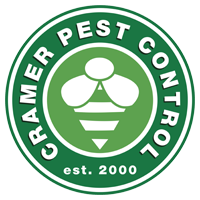
Cramer Pest Control is now a Lookout Partner! Receive the same great Cramer Service, now with extended services and resources! Start today and get $50 off your initial Mosquito service or visit lookout to learn more about mosquito prevention and treatments.
Mosquito Species in South Carolina: What You Need to Know in North Carolina and South Carolina
Protecting North Carolina and South Carolina

